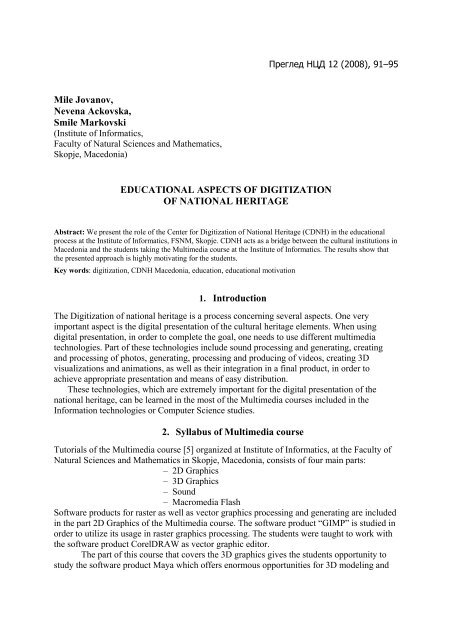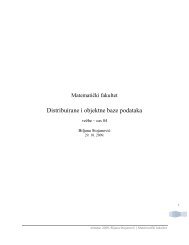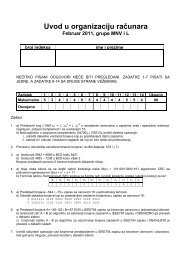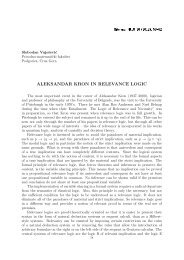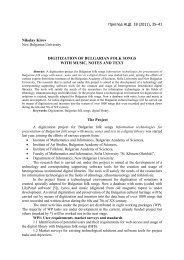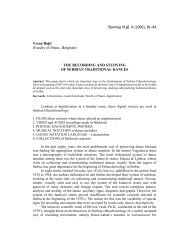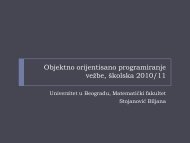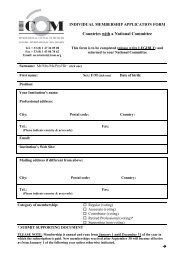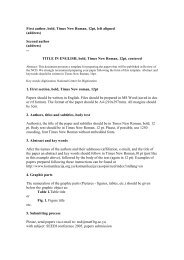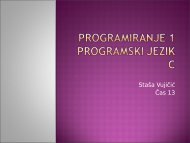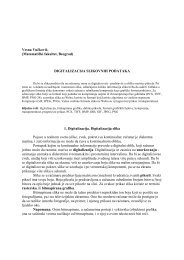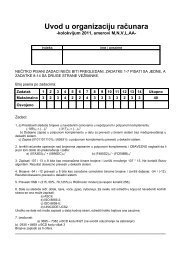Mile Jovanov, Nevena Ackovska, Smile ... - Ncd.matf.bg.ac.rs
Mile Jovanov, Nevena Ackovska, Smile ... - Ncd.matf.bg.ac.rs
Mile Jovanov, Nevena Ackovska, Smile ... - Ncd.matf.bg.ac.rs
Create successful ePaper yourself
Turn your PDF publications into a flip-book with our unique Google optimized e-Paper software.
Преглед НЦД 12 (2008), 91–95<br />
<strong>Mile</strong> <strong>Jovanov</strong>,<br />
<strong>Nevena</strong> <strong>Ackovska</strong>,<br />
<strong>Smile</strong> Markovski<br />
(Institute of Informatics,<br />
F<strong>ac</strong>ulty of Natural Sciences and Mathematics,<br />
Skopje, M<strong>ac</strong>edonia)<br />
EDUCATIONAL ASPECTS OF DIGITIZATION<br />
OF NATIONAL HERITAGE<br />
Abstr<strong>ac</strong>t: We present the role of the Center for Digitization of National Heritage (CDNH) in the educational<br />
process at the Institute of Informatics, FSNM, Skopje. CDNH <strong>ac</strong>ts as a bridge between the cultural institutions in<br />
M<strong>ac</strong>edonia and the students taking the Multimedia cou<strong>rs</strong>e at the Institute of Informatics. The results show that<br />
the presented appro<strong>ac</strong>h is highly motivating for the students.<br />
Key words: digitization, CDNH M<strong>ac</strong>edonia, education, educational motivation<br />
1. Introduction<br />
The Digitization of national heritage is a process concerning several aspects. One very<br />
important aspect is the digital presentation of the cultural heritage elements. When using<br />
digital presentation, in order to complete the goal, one needs to use different multimedia<br />
technologies. Part of these technologies include sound processing and generating, creating<br />
and processing of photos, generating, processing and producing of videos, creating 3D<br />
visualizations and animations, as well as their integration in a final product, in order to<br />
<strong>ac</strong>hieve appropriate presentation and means of easy distribution.<br />
These technologies, which are extremely important for the digital presentation of the<br />
national heritage, can be learned in the most of the Multimedia cou<strong>rs</strong>es included in the<br />
Information technologies or Computer Science studies.<br />
2. Syllabus of Multimedia cou<strong>rs</strong>e<br />
Tutorials of the Multimedia cou<strong>rs</strong>e [5] organized at Institute of Informatics, at the F<strong>ac</strong>ulty of<br />
Natural Sciences and Mathematics in Skopje, M<strong>ac</strong>edonia, consists of four main parts:<br />
– 2D Graphics<br />
– 3D Graphics<br />
– Sound<br />
– M<strong>ac</strong>romedia Flash<br />
Software products for raster as well as vector graphics processing and generating are included<br />
in the part 2D Graphics of the Multimedia cou<strong>rs</strong>e. The software product “GIMP” is studied in<br />
order to utilize its usage in raster graphics processing. The students were taught to work with<br />
the software product CorelDRAW as vector graphic editor.<br />
The part of this cou<strong>rs</strong>e that cove<strong>rs</strong> the 3D graphics gives the students opportunity to<br />
study the software product Maya which offe<strong>rs</strong> enormous opportunities for 3D modeling and
92<br />
<strong>Mile</strong> <strong>Jovanov</strong>, <strong>Nevena</strong> <strong>Ackovska</strong>, <strong>Smile</strong> Markovski<br />
animation. The software product “VirtualDub” as tool for video capture and linear processing<br />
was also introduced.<br />
The part of the cou<strong>rs</strong>e where Sound is thought includes 3 parts: “Aud<strong>ac</strong>ity” - software<br />
product for sound processing, “Anvil Studio” as software for sound generation, and MIDI<br />
programming.<br />
The fourth part of the Multimedia Pr<strong>ac</strong>ticum studies the software p<strong>ac</strong>kage<br />
M<strong>ac</strong>romedia Flash and Action Script as part of it, as an integrative tool which enables<br />
production of dynamic, web oriented contents. Additional efforts were made to demonstrate<br />
the students its feasibility in web page editing, and panorama making.<br />
3. CDNH <strong>ac</strong>tivities<br />
The Center for Digitization of National Heritage (CDNH) at the Institute of Informatics was<br />
officially opened at March 1, 2005. CDNH <strong>ac</strong>tivities are focused toward development of a<br />
digitized presentation of the national heritage of M<strong>ac</strong>edonia via the following <strong>ac</strong>tivities:<br />
building a web portal of the CDNH [1], producing application programs and programming<br />
tools for national heritage presentation [2, 3], organizing semina<strong>rs</strong>, workshops and<br />
conferences [4], involving new te<strong>ac</strong>hing materials in student’s education at Institute of<br />
Informatics [5], etc.<br />
4. The bridge between the education and the cultural institutions<br />
The digital presentation of the national heritage of one country incorporates the usage of the<br />
previously mentioned technologies. This enables the students to apply their knowledge of<br />
multimedia technologies in generating projects in this particularly modern and very attr<strong>ac</strong>tive<br />
CDNH<br />
Multimedia<br />
cou<strong>rs</strong>e<br />
curricula<br />
Educational<br />
institution<br />
Project<br />
Project<br />
Project<br />
Project<br />
Project<br />
Lecturer<br />
Cultural<br />
Institution<br />
Cont<strong>ac</strong>t<br />
pe<strong>rs</strong>on<br />
Fig. 1. CDNH – bridge between education and culture
<strong>Mile</strong> <strong>Jovanov</strong>, <strong>Nevena</strong> <strong>Ackovska</strong>, <strong>Smile</strong> Markovski 93<br />
area. The projects include presentations of very important segments of M<strong>ac</strong>edonian national<br />
heritage. They were created as part of collaboration between the Center of digitization of<br />
National Heritage of M<strong>ac</strong>edonia (CDNH) at the Institute of Informatics, and the students<br />
taking the Multimedia cou<strong>rs</strong>e. The role of CDNH is to communicate with the relevant<br />
institutions involved in the conservation of M<strong>ac</strong>edonian national heritage, to unde<strong>rs</strong>tand the<br />
needs of these institutions, to prepare <strong>ac</strong>tion plan for the forthcoming <strong>ac</strong>tivities and projects,<br />
and to complete those projects. These <strong>ac</strong>tivities include the creation of various digital<br />
presentations, their integration in web pages for Internet presentations and as part of CD<br />
presentations. On the other hand, CDNH in the collaboration with the management of the<br />
Multimedia cou<strong>rs</strong>e obtains great number of digitized content ready to use for other impending<br />
projects. The role of CDNH as a bridge between the educational process at the Institute of<br />
Informatics, and the cultural institutions in M<strong>ac</strong>edonia, is shown in Fig.1.<br />
5. Case study<br />
The project “Ubavinite na Matka” (“Matka Beauties”) included presentation of three<br />
monasteries in the Matka region, near Skopje. All material for presentation, produced by<br />
students, was assembled in web site developed using Flash technology. (Fig. 2)<br />
Fig. 2. The home page of the project “Ubavinite na Matka”<br />
Fig. 3. Part of the picture gallery of the project “Ubavinite na Matka”
94<br />
<strong>Mile</strong> <strong>Jovanov</strong>, <strong>Nevena</strong> <strong>Ackovska</strong>, <strong>Smile</strong> Markovski<br />
Among the materials included in the project there were rich picture galleries that present the<br />
monasteries, shown in Fig.3. Also, 3D models of all monasteries were made giving the full<br />
unde<strong>rs</strong>tanding of their architecture (Fig. 4).<br />
Fig. 4. 3D model of one of the monasteries in the Matka region<br />
The region was shown using panorama views, too (Fig. 5).<br />
Fig. 5. Panorama view of one of the Matka’s monasteries<br />
Sound effects and music are played, while browsing the site.<br />
During the making of the project students demonstrated knowledge of all of the studied<br />
technologies taught in the Multimedia cou<strong>rs</strong>e.<br />
6. Results<br />
This appro<strong>ac</strong>h in te<strong>ac</strong>hing Multimedia cou<strong>rs</strong>e enables the students to create part of the<br />
projects that are incorporated in the official digital presentation of the national heritage of<br />
Republic of M<strong>ac</strong>edonia. The idea that their work is presented to broader M<strong>ac</strong>edonian<br />
community motivates them to <strong>ac</strong>hieve their maximal potentials, both in qualitative as well as<br />
in the quantitative aspect of the project creation.<br />
In order to enable wide domain of the work for the students, there are no limitations<br />
about the subject and the outlook of the projects. This gives the students opportunity to<br />
express their own creativity. As a result, there are projects with different thematic, but more<br />
interesting, there are lot of different ways of presentation. The students usually discover how<br />
to use the same technique in a different manner in order to produce an original project.
<strong>Mile</strong> <strong>Jovanov</strong>, <strong>Nevena</strong> <strong>Ackovska</strong>, <strong>Smile</strong> Markovski 95<br />
Learning Multimedia through these types of pr<strong>ac</strong>tical projects is very useful and productive<br />
for the students. The students work in teams and they learn how to work together with other<br />
people. In addition, they are taking their fi<strong>rs</strong>t steps toward project management. These kind of<br />
multidisciplinary projects give them the opportunity to communicate with people of different<br />
fields and our students have chance to work together with people from the culture community.<br />
It is obvious that the students are interested in this cou<strong>rs</strong>e. They try to learn as much as<br />
possible, and after finishing the cou<strong>rs</strong>e they have enough pr<strong>ac</strong>tical knowledge in multimedia<br />
area. In our experience, the students don’t find the learning techniques difficult to learn. Even<br />
more, it proves that the team work, the preparation of the project and the necessary<br />
communication are more difficult for them.<br />
7. Conclusion<br />
The digital presentation of national heritage offe<strong>rs</strong> enormous opportunities in application of<br />
the students’ skills <strong>ac</strong>quired in the cou<strong>rs</strong>e of Multimedia. It is evident that due to the f<strong>ac</strong>t that<br />
these projects are available to broader public through their web <strong>ac</strong>cessibility, the students are<br />
highly motivated to create more interesting presentations. The motivation itself leads the<br />
students to global unde<strong>rs</strong>tanding of the multimedia technologies and a desire to master all of<br />
the software products taught in the Multimedia cou<strong>rs</strong>e.<br />
Also, through this type of projects, the students have an opportunity to feel the real<br />
team spirit, field project qualities and problems, managing the time and resources, and<br />
communication with authorities and people from the cultural and historical community of the<br />
Republic of M<strong>ac</strong>edonia.<br />
Acknowledgements. The autho<strong>rs</strong> wish to thank Nikola Lazovski, Goran Kolevski, Marjan<br />
Kindalov and Nikolche Mihajlovski for their effort in producing valuable te<strong>ac</strong>hing materials<br />
for Multimedia cou<strong>rs</strong>e. This research was supported by Center for Digitization of National<br />
Heritage of M<strong>ac</strong>edonia at Institute of Informatics, FSNM, Skopje, M<strong>ac</strong>edonia.<br />
References<br />
[1] S. Markovski, G. Armenski, P. Miloshev, N. Mihajlovski, Web portal of the CDNH M<strong>ac</strong>edonia,<br />
www.cdnh.edu.mk<br />
[2] M. <strong>Jovanov</strong>, M. Kindalov, G. Kolevski, P. Miloshev, N. Mihajlovski. System for storing data about<br />
national heritage with advanced search techniques, Review of NCD 9 (2006).<br />
[3] N. <strong>Ackovska</strong>, M. <strong>Jovanov</strong>, D. Aleksovski, V. Atanasov, B. Endrovski „Software for digitization of ancient<br />
Slavic glagolic handwritten manuscripts“, Book of extended abstr<strong>ac</strong>ts, ISBN 9989-668-46-9<br />
[4] N. <strong>Ackovska</strong>, official site of the Fi<strong>rs</strong>t SEEDI Conference, www.ii.edu.mk/SEEDI2005/<br />
[5] M. <strong>Jovanov</strong>, S. Markovski, web page of the cou<strong>rs</strong>e Multimedia, Мултимедија 2006/2007 at<br />
cou<strong>rs</strong>es.ii.edu.mk


